
Heracleum mantegazzianum, commonly known as giant hogweed, is a monocarpic perennial herbaceous plant in the carrot family Apiaceae. H. mantegazzianum is also known as cartwheel-flower, giant cow parsley, giant cow parsnip, or hogsbane. In New Zealand, it is also sometimes called wild parsnip or wild rhubarb.

A perennial plant or simply perennial is a plant that lives more than two years. The term is often used to differentiate a plant from shorter-lived annuals and biennials. The term is also widely used to distinguish plants with little or no woody growth from trees and shrubs, which are also technically perennials.

Hibiscus laevis, the halberd-leaf rosemallow, is a herbaceous perennial flower native to central and eastern North America. Their showy, creamy-white or pink flowers are large, up to 15 centimetres (6 in) across, and are hard to miss. These flowers require exposure to sunlight to open up properly, and then last only a single day.
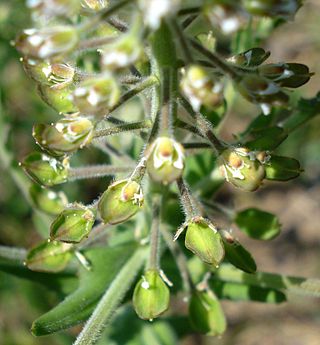
Lepidium campestre, the field pepperwort or field pepperweed or field cress, is usually a biennial with some form of annual plant in the Brassicaceae or mustard family, native to Europe, but commonly found in North America as an invasive weed. The most notable characteristic of field pepperweed is the raceme of flowers which forks off of the stem. These racemes are made up of first small white flowers and later green, flat and oval seedpods each about 6 mm long and 4 mm wide. Each seedpod contains two brown, 2.5 mm long seeds.

Lepidium virginicum, also known as least pepperwort or Virginia pepperweed, is an herbaceous plant in the mustard family (Brassicaceae). It is native to much of North America, including most of the United States and Mexico and southern regions of Canada, as well as most of Central America. It can be found elsewhere as an introduced species.
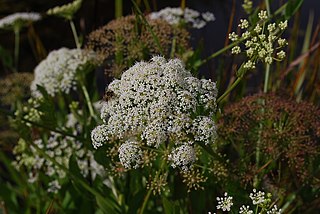
Sium latifolium is a species of flowering plant in the family Apiaceae known by the common names great water-parsnip, greater water-parsnip, and wideleaf waterparsnip. It is native to much of Europe, Kazakhstan, and Siberia.
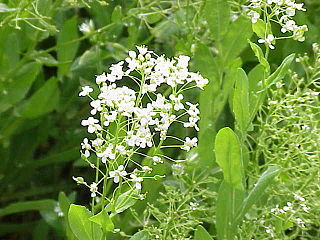
Lepidium draba, also known as whitetop, hoary cress, or Thanet cress, is a rhizomatous perennial flowering plant in the family Brassicaceae. It is native to western Asia and southeastern Europe and has been widely introduced elsewhere.

Lepidium densiflorum is a species of flowering plant in the mustard family known by the common names common pepperweed and prairie peppergrass.

Lepidium flavum is a species of flowering plant in the mustard family known by the common name yellow pepperweed. It is native to California, Nevada, and Baja California, where it grows in the Sonoran and Mojave Deserts. The species epithet flavum is Latin for yellow and indicates its flower colour.

Lepidium fremontii, the desert pepperweed, is a species of flowering plant in the mustard family which is native to the southwestern United States, where it grows on sandy desert flats and the rocky slopes of nearby hills and mountains. It takes its scientific name from John C. Frémont.

Lepidium latipes is a species of flowering plant in the mustard family known by the common name San Diego pepperweed. It is native to California and Baja California, where it grows in alkaline soils in a number of habitat types.

Lepidium montanum is a species of flowering plant in the mustard family known by the common names mountain pepperweed, mountain peppergrass, mountain pepperwort, and mountain pepperplant. It is native to western North America from Oregon to Montana to northern Mexico, where it can be found in a number of habitats, often on salty or gravelly soils. There are several varieties, many of which are difficult to distinguish.

Lepidium nitidum, known by the common name shining pepperweed, is a species of flowering plant in the mustard family.

Lepidium dictyotum is a species of flowering plant in the mustard family known by the common names alkali pepperweed and alkali pepperwort.
Lepidium pinnatifidum is a species of flowering plant in the mustard family known in English by the common name featherleaf pepperweed.

Lepidium barnebyanum is a rare species of flowering plant in the family Brassicaceae known by the common names Barneby's pepperweed, Barneby's pepper-grass, and Barneby's ridge-cress. It is endemic to Utah, where there is a single population in Duchesne County. It is a federally listed endangered species of the United States.
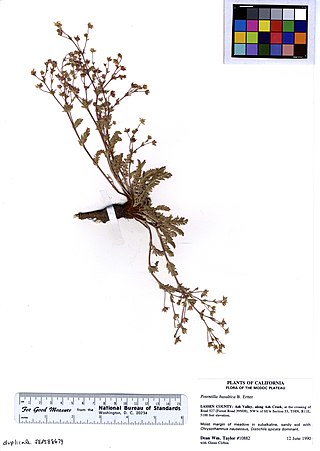
Potentilla basaltica is a species of flowering plant in the rose family known by the common names Soldier Meadows cinquefoil and basalt cinquefoil. It is endemic to a small area of the Modoc Plateau and Warner Mountains in northeastern California and northwestern Nevada.

Setaria palmifolia is a species of grass known by the common names palmgrass, highland pitpit, hailans pitpit, short pitpit, broadleaved bristlegrass, and knotroot. In Spanish it is called pasto de palma and in Samoan vao 'ofe 'ofe. It is native to temperate and tropical Asia. It is known elsewhere as an introduced, and often invasive, species, including in Australia, New Zealand, many Pacific Islands, and the Americas.
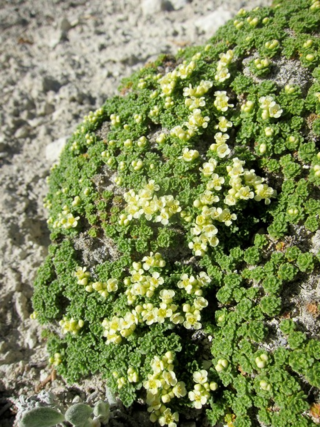
Lepidium nanum, the dwarf pepperweed, is a plant species native to the US states of Nevada and Utah. It is known from four counties in Nevada but only one in Utah. It occurs in open, sunlit areas in the desert, often with gypsum, limestone, quartzite or chalky soils.

Lepidium heterophyllum,, is a species of flowering plant in the mustard family which is native to parts of western Europe, growing in shingle banks, wasteland or cultivated fields.



















